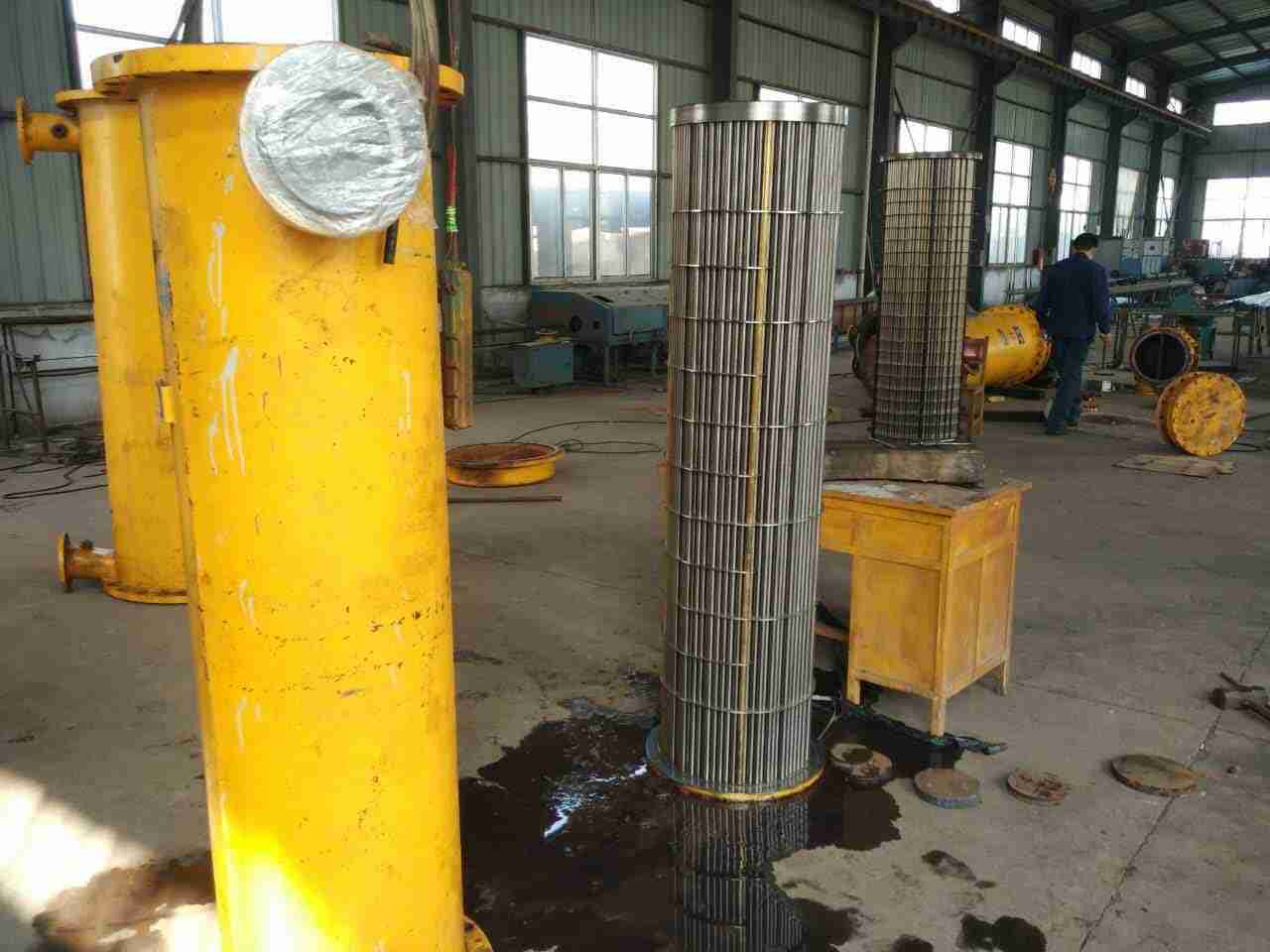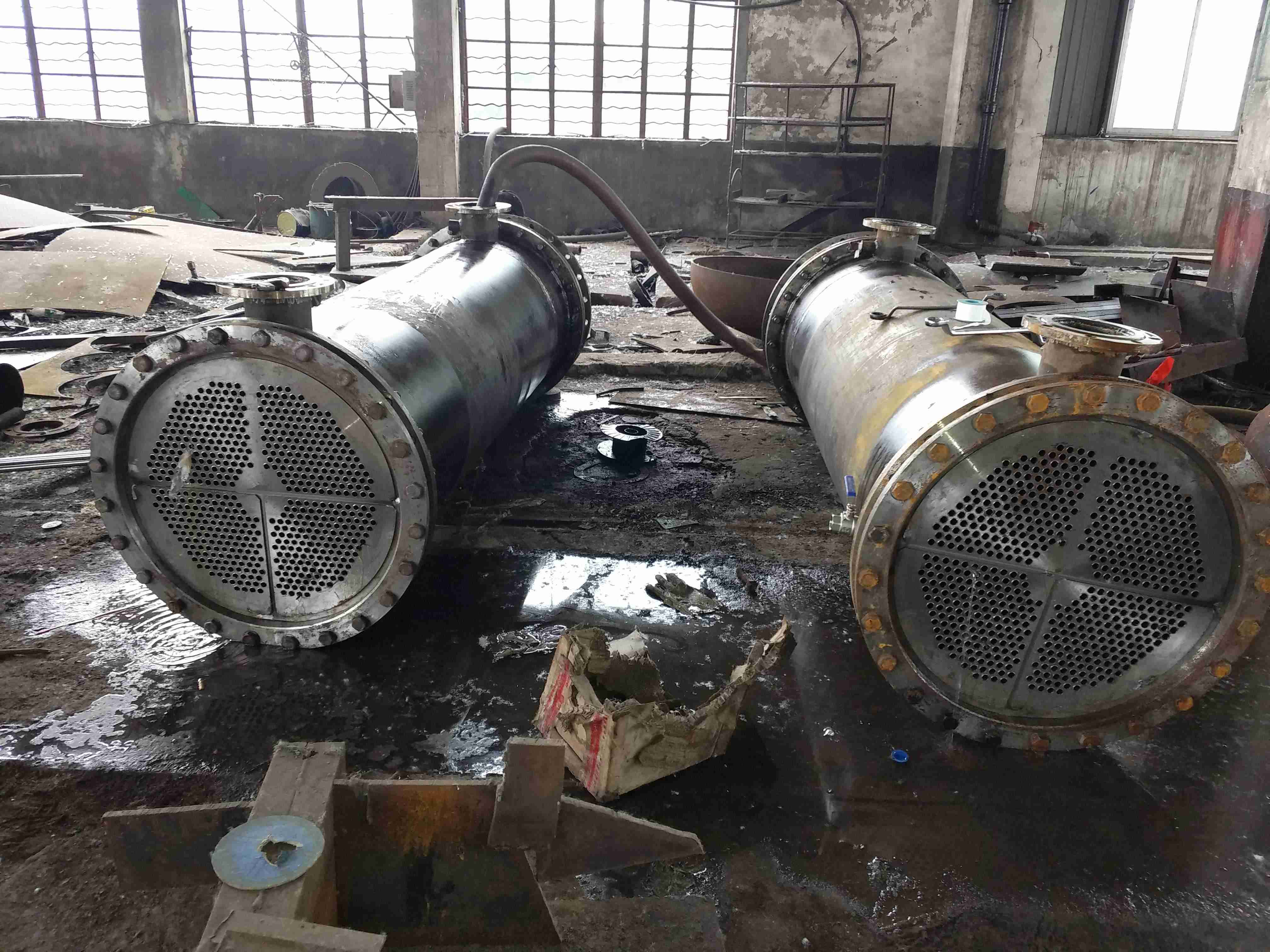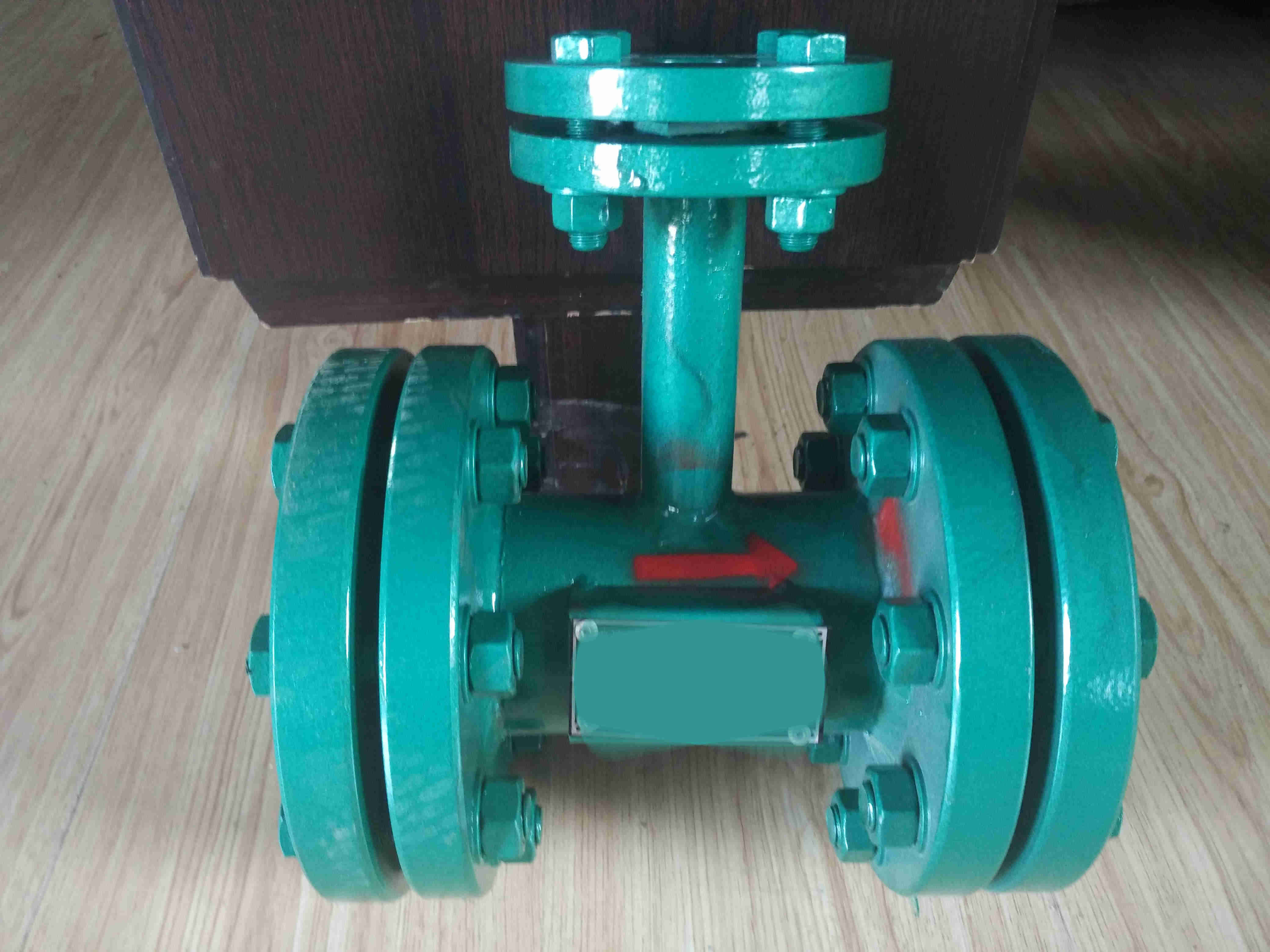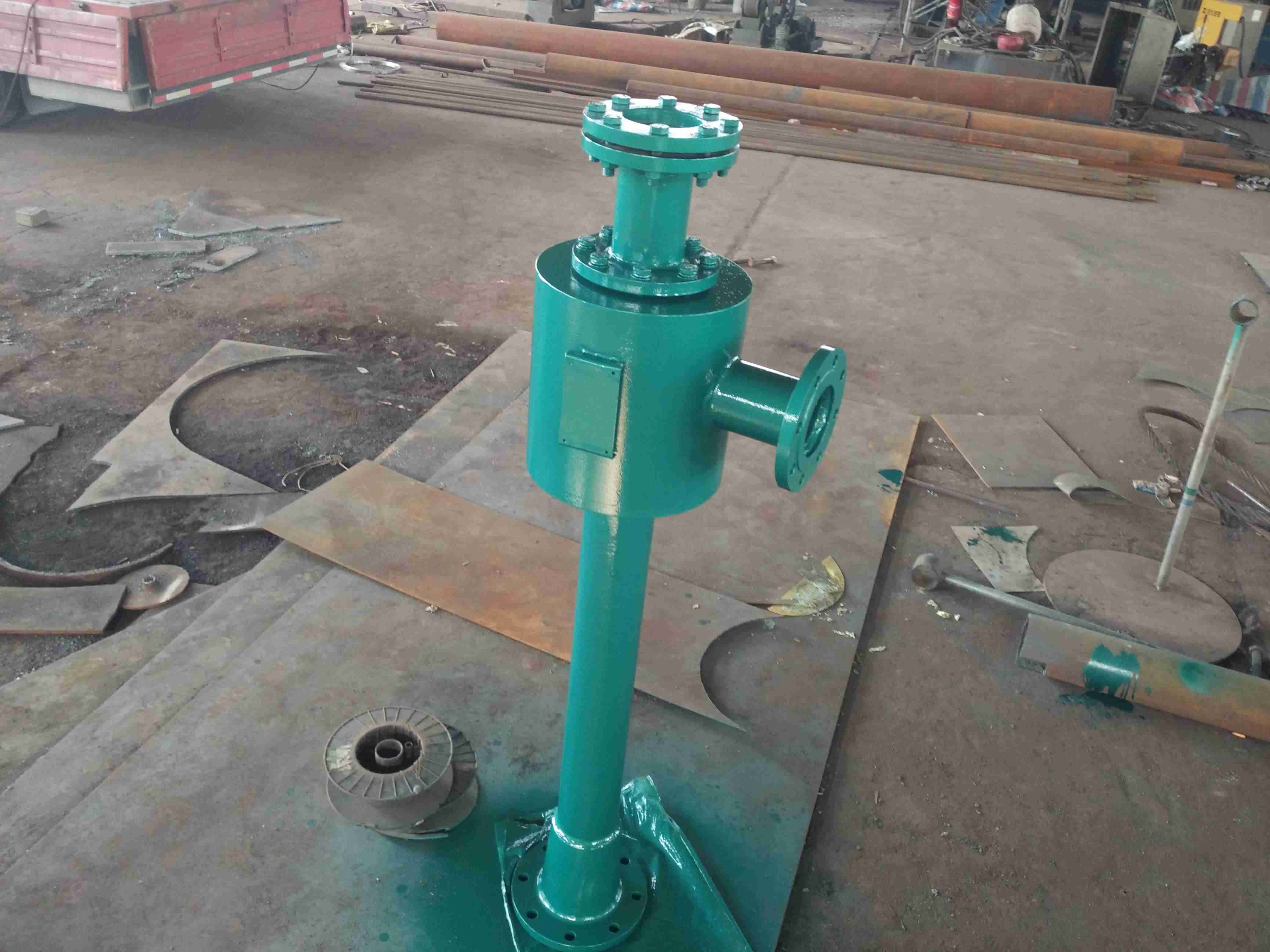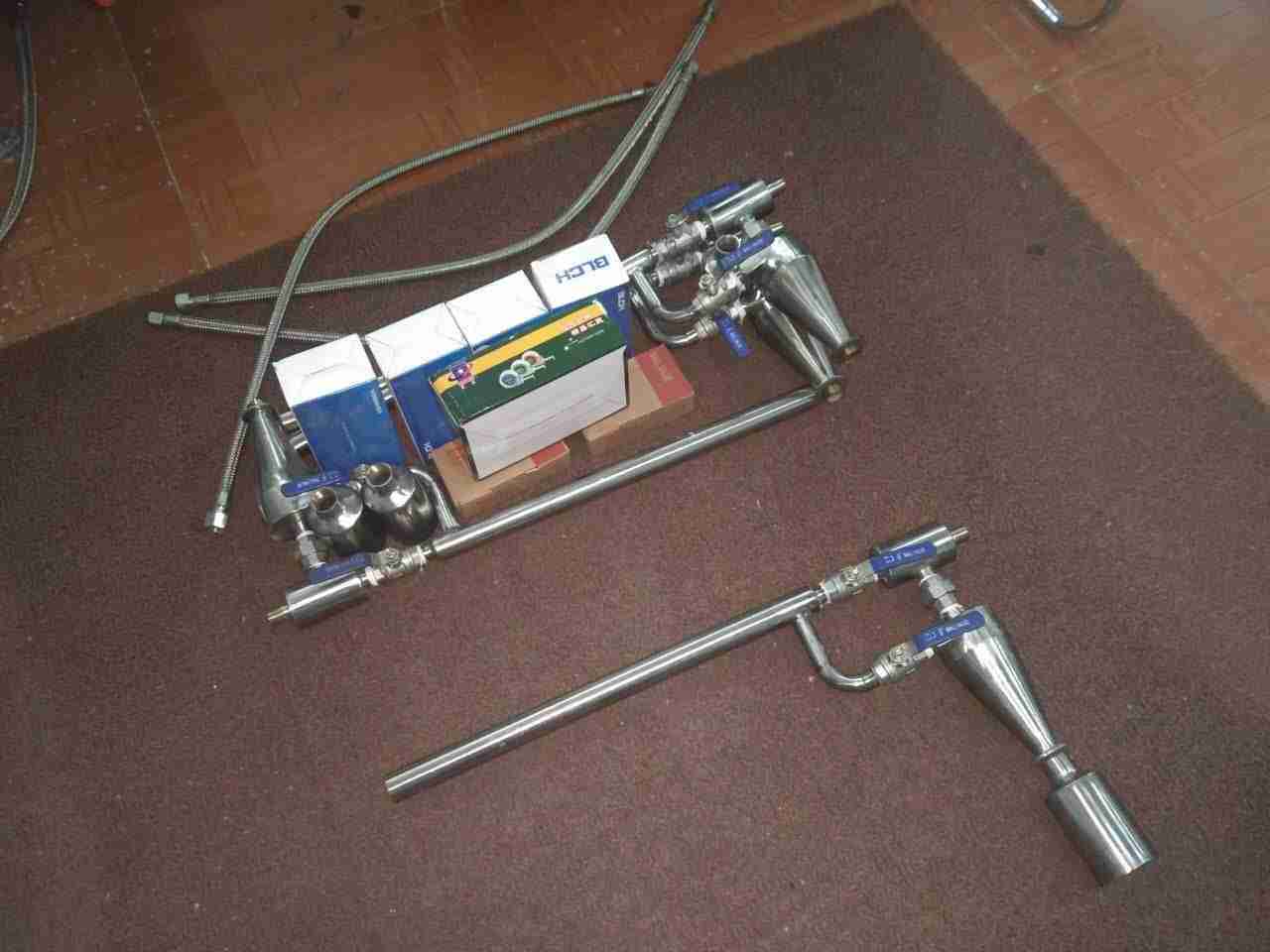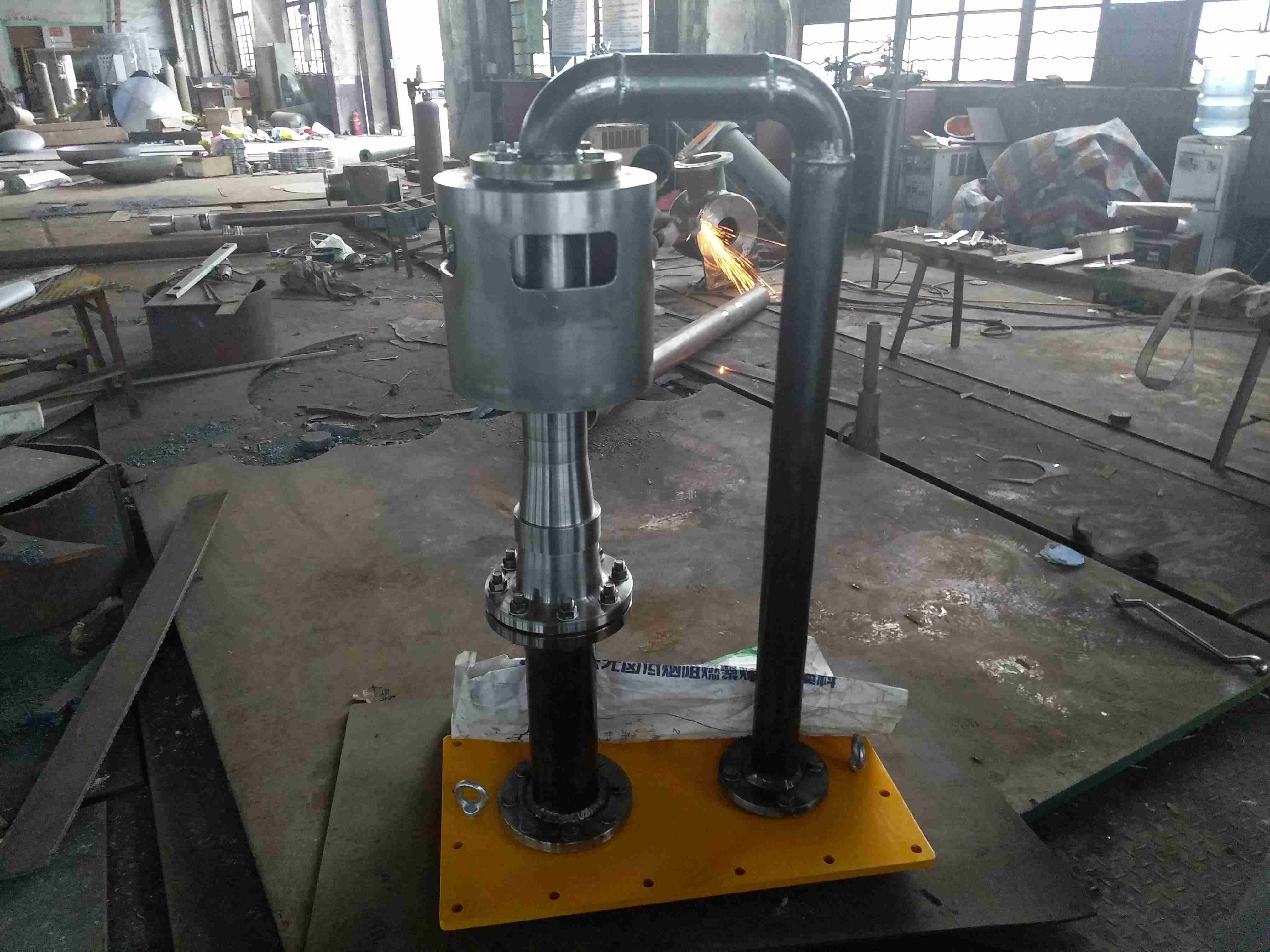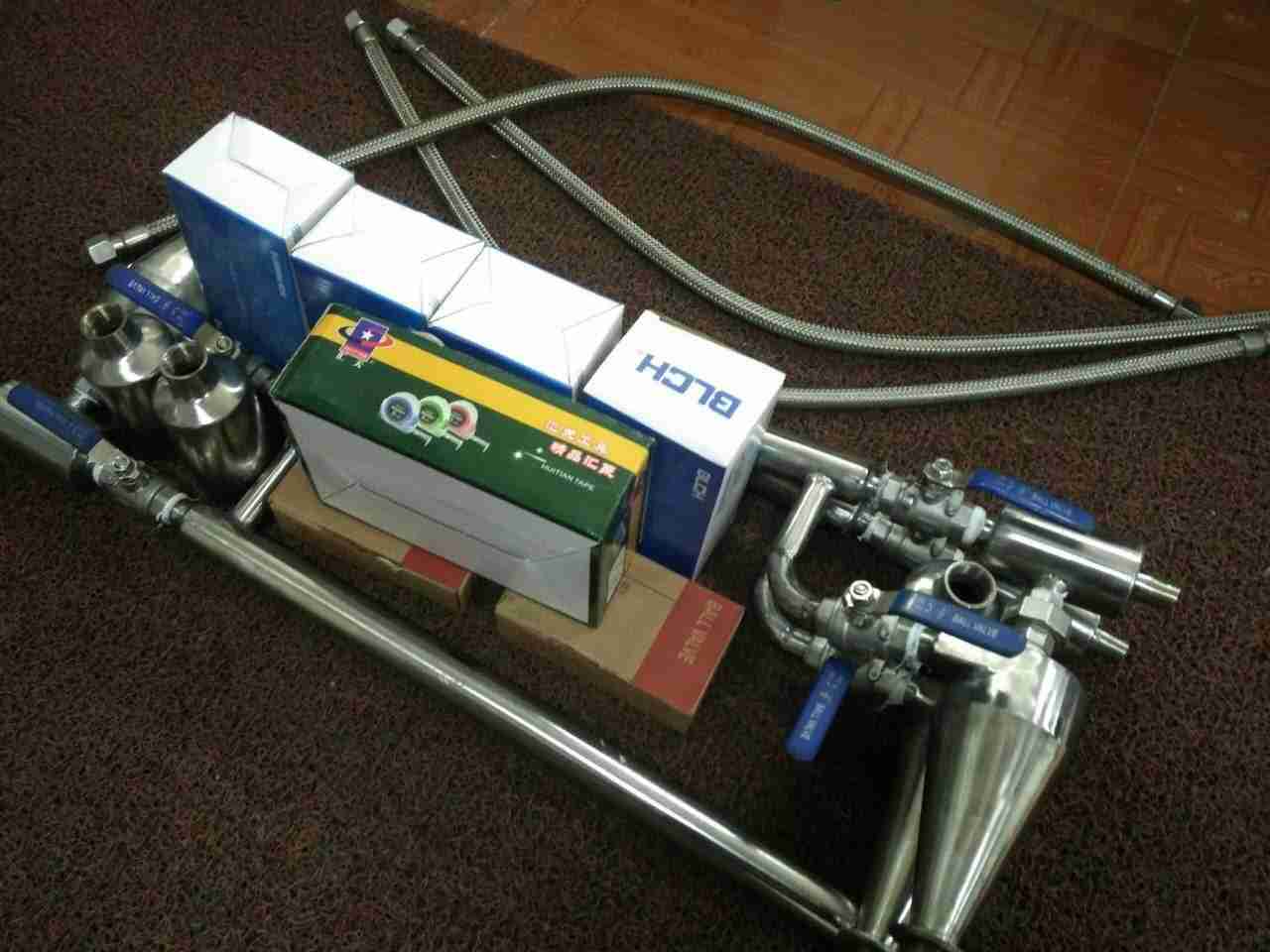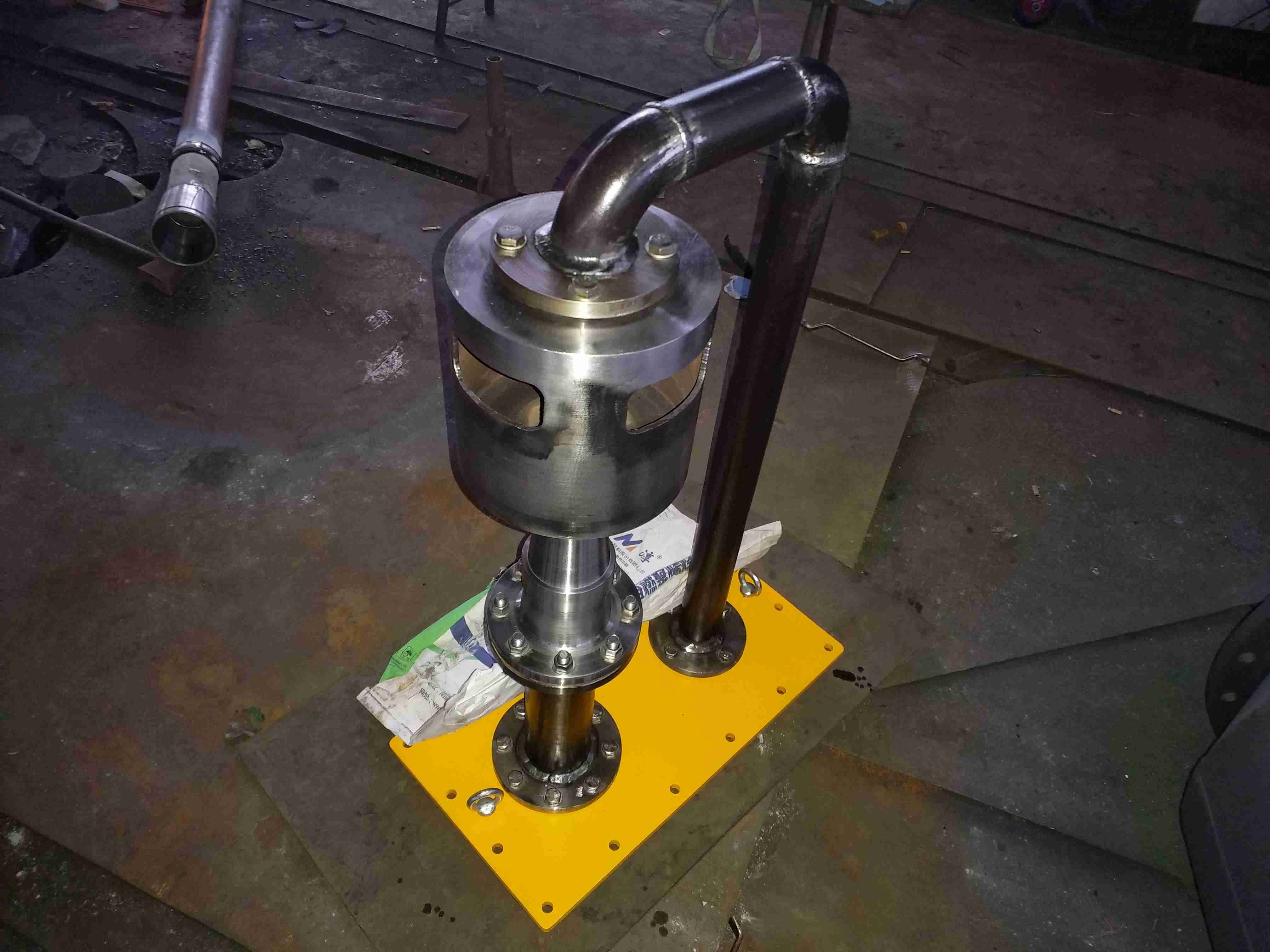Overview of replacing stainless steel pipes for steam turbine oil coolers:
Lianyungang Lingdong Electromechanical Equipment Co., Ltd. is engaged in the transformation of steam turbine oil cooler tubes and copper tubes into stainless steel tubes. 304/316l stainless steel tube heat exchange tubes have high resistance to vibration, scaling, and corrosion. Stainless steel tube heat exchange tubes have overcome the industry's previous challenges of reducing wall thickness to enhance heat transfer or using spiral rolling on the tube wall to weaken tube stiffness, resulting in reduced wall thickness, enhanced heat transfer, and increased stiffness, Simultaneously possessing anti vibration and anti scaling properties.
Introduction to Welding Steel Pipe for Stainless Steel Pipe Replacement of Steam Turbine Oil Cooler:
Welded steel pipes (also known as slotted pipes and welded pipes) for replacing steam turbine oil coolers are mainly used in auxiliary machinery in industries such as thermal power generation, chemical industry, and steel, such as condenser and heater pipe replacement, tubular turbine oil cooler pipe replacement, oil-water cooler pipe replacement, tubular turbine oil cooler pipe replacement, Le tube cooler pipe replacement, turbine oil cooler pipe replacement, and marine turbine oil cooler pipe replacement, Chiller - replace 304/316l stainless steel pipes, condenser - replace 304/316l stainless steel pipes, heat exchanger - replace 304/316l stainless steel pipes, heat exchanger - replace 304/316l stainless steel pipes, shaft seal heater - replace 304/316l stainless steel pipes, steam seal heater - replace 304/316l stainless steel pipes, low-pressure heater - replace 304/316l stainless steel pipes, air preheater pipes, air cooler pipes, air cooler pipes, waste heat recovery device pipes, and volumetric heat exchanger pipes, Energy harvester tube replacement and related tube bundle tube replacement. Steam turbine oil cooler tube replacement, steam turbine oil cooler tube replacement, stainless steel tube heat exchange tube specification: diameter Ф 12~ Ф 32mm, with a wall thickness of 0.6-3.0mm. The deviation value of the pipe wall thickness is ± 0.05mm, and there are two types of lengths: fixed length and indefinite length- The types of stainless steel pipes used include 304, 304L, 316, 316L, 317, and 317L.
Process requirements for replacing stainless steel pipes in steam turbine oil coolers:
1. Preparation of stainless steel pipe: Cut the qualified stainless steel pipe according to the size of the turbine oil cooler. The stainless steel pipe should be 4-5 millimeters longer than the pipe plate. Remove burrs from both ends of the stainless steel pipe, polish the expanded part smooth, and perform tempering treatment at about 50 millimeters at both ends.
2. Remove old stainless steel tubes: Use a semi-circular triangular chisel to remove them. When removing, be careful not to damage the tube plate. Polish the stainless steel tube, remove the old stainless steel tube, clean the tube plate hole, polish it with a fine sandcloth, and wipe off the dust with a cloth.
3. Pipe threading and expansion: After both the pipe plate and stainless steel pipe are prepared, they can be threaded through the stainless steel pipe. Be careful not to use too much force or force, align them with your own hole position, and install them. The exposed parts at both ends of the pipe should be equal. The diameter of the pipe plate hole is slightly larger than the pipe diameter, about 0.5 millimeters, and should not be too large or too small. After the stainless steel pipe is threaded, a pipe expander can be used to expand the mouth. When expanding the pipe, the force and speed should not be too large or too small. The length of the expanded pipe should be 2/3 of the thickness of the pipe plate, and should not be greater than the thickness of the pipe plate. After the expansion is completed, both ends should be flanged with a punch.
4. When replacing stainless steel pipes, it is necessary to replace them half by half, and then disassemble the other half.
5. The welded joint after pipe replacement needs to undergo leakage or damage testing.
6. The transformation of the steam turbine oil cooler involves dismantling and shipping the entire steam turbine oil cooler equipment to our company for tube bundle replacement. This is more economical than on-site tube replacement - it increases the speed of tube and core replacement. The replacement speed of the steam turbine oil cooler is slow during the production time of the pipes, as they are all customized. Once the pipes are finished, the assembly speed of the replacement pipes can be completed in 3-5 days!
The steam turbine oil cooler adopts seamless stainless steel pipes (welded pipes, also known as straight seam pipes) for pipe replacement
The welded steel pipe used for the replacement of the steam turbine oil cooler is manufactured using imported pipe manufacturing equipment, which is equivalent to or slightly stronger than stainless steel pipes. The metallographic structure of the weld seam is slightly different from that of the base material, and the mechanical properties such as strength are also slightly different. Due to the uniform thickness and smooth surface of the stainless steel pipe strip, it is indeed better than cold drawn, hot rolled, and seam stainless steel pipes of the same material. The elongation is greater than 35%, and the hardness is small, making it easy to expand and connect.
The replacement of stainless steel pipes for steam turbine oil coolers includes the following:
1. Stainless steel tube heat exchange tube heat transfer energy. Due to the use of thin-walled stainless steel tubes with a wall thickness of 0.5-0.7mm, the overall heat transfer energy is improved. Under the same heat exchange area, the overall heat transfer coefficient is 2.124-8.408% higher than that of copper tubes.
2. Due to the use of American standard AISl304, 316l and other stainless alloy steels for the pipes, they have high hardness and the rigidity of stainless steel pipes is also significantly improved. Therefore, it has strong impact energy and anti vibration energy of high-temperature steam.
3. Due to the smooth inner wall of stainless steel pipes, the thickness of the bottom layer of the boundary laminar flow is reduced, which not only enhances heat transfer but also improves the ability to resist scaling.
4. The process of replacing the steam turbine oil cooler with stainless steel tube and heat exchange tube adopts the expansion tube technology of transmission. The outer diameter tolerance of the stainless steel tube is the same as that of the copper tube, and there is no need to change the machining tolerance of the tube plate hole, which is conducive to direct selection on site and convenient for changing the tube of the steam turbine oil cooler.
5.304/316l stainless steel heat exchange tubes are economical. Under the same heat exchange area, the cost of stainless steel tubes is about 80% of the cost of copper tubes, and can be directly transformed into tube bundles.
In order to eliminate welding stress on heat exchange tubes, heat treatment is carried out at a high temperature of 1050 ℃ under protective gas.
7. All pipes are subjected to pressure difference method for leakage inspection, with a pressure test reaching 1.0Mpa and a pressure drop of 5 minutes.
Steam turbine oil cooler tube replacement: Stainless steel tube structure for steam turbine oil cooler tube replacement:
1. Heat transfer energy difference, due to the use of thin-walled stainless steel tubes with a wall thickness of 0.5-0.8mm, the heat transfer energy is improved. Under the same heat transfer area, 304/316L stainless steel heat transfer tubes are about 1.2-1.30 times larger than copper tubes
2. Strong corrosion resistance, corrosion resistance, ammonia corrosion, and general corrosion. 304/316L stainless steel heat exchange tubes can be used for more than 10 years.
3. Due to the use of high-energy stainless alloy steels such as TP304 and TP316L as stainless steel materials, the surface has high strength, and the inner wall of the pipe is smooth, which reduces the thickness of the boundary laminar flow layer. Therefore, it has strong high-temperature steam erosion energy.
4. The rigidity and vibration resistance of the pipe are improved.
5. Strengthening the heat exchange tube has improved the ability to resist scaling.
6. The process of installing stainless steel heat exchange tubes can be achieved by using the expansion tube technology of transmission. The outer diameter tolerance is consistent with the steel pipe, and there is no need to change the machining tolerance of the tube plate hole, which is conducive to direct selection and convenient for replacing stainless steel tubes with copper tubes in the unit
7. Economically, under the same heat exchange area, the cost is about 60% of copper tubes, and stainless steel heat exchange tubes can be directly used for tube exchange.
8. Stainless steel heat exchange tubes are made by highly automated pipe making equipment, which is formed by self corrosion solution welding and flipping. Under any metal filler, they are filled with gas protection (inner and outer sides of the tube) and welded. The welding method is TIG process and undergoes in solution eddy current testing.
9. In order to eliminate the stress on the pipe, heat treatment can be carried out at a high temperature of 1040 ℃ under protective gas, or time-vibration treatment can be carried out as needed.
10. All steel pipes shall be subjected to water pressure pneumatic testing one by one, and the pressure shall be tested to within 10Mpa for 10 seconds before depressurization.
11. After leaving the factory, conduct eddy current testing on each tube, with a frequency of 10-30 kHz.
12. The outer diameter deviation of the pipe is generally ± 0.10mm, the wall thickness deviation is ± 10%, and the length deviation is ± 5mm.
13. All pipes shall be checked for their full length using a gauge.
14. The raw materials entering the factory and the finished products being shipped are both tested and a test report is issued.
The general principle for selecting pipes for tube bundle replacement is:
1. No severe corrosion leakage, use as long as possible, erosion and wear, vibration resistance, high heat transfer coefficient, and reasonable structure. For decades, copper pipes have been used in my condensers, steam turbine oil coolers, chillers, and other equipment due to their high thermal conductivity.
2. In practice, some copper pipes of the condenser are subjected to severe ammonia corrosion, while others are subjected to severe wear and tear. These two phenomena cause copper pipes to leak tightly, greatly reducing the use of copper pipes, reducing the safety and economy of unit operation, and increasing the time for shutdown and replacement of copper pipes. Therefore, many people have started to consider the issue of condenser pipe materials.
In recent years, stainless steel heat exchange tubes have been widely used in condensers, steam turbine oil coolers, air coolers, low-pressure heaters, high-pressure heaters, air coolers, heat exchangers, chillers, and air preheaters. According to incomplete calculations, the units used are over 50%, including 50-300MW units. The use of 304/316l stainless steel heat exchange tubes has broken the traditional concept of only using copper tubes, improved equipment safety and economy, and reduced investment.
However, there are still many people who lack interest in the use of stainless steel heat exchange tubes for steam turbine oil coolers. The main reason is that the thermal conductivity of stainless steel heat exchange tubes is much lower than that of copper tubes, which may affect heat transfer. For this reason, relevant units have conducted many studies on the overall heat transfer coefficient of stainless steel heat exchange tubes used in condensers, and have achieved great results. More and more power plants are replacing copper pipes with stainless steel pipes.
Cooling equipment - using stainless steel heat exchange tubes (cooling tubes):
Stainless steel heat exchange tubes and cooling tubes are produced using advanced automation, technology, and process. Select ASTM 304 and 316L standard stainless steel materials for good processing and production.
Stainless steel pipes are used for replacing the oil cooler pipes of the steam turbine
-High temperature steam, erosion resistance, anti scaling, anti oxidation corrosion, strong vibration resistance, and wear resistance.
Heat exchange - material -, thin tube wall, smooth inner wall, and enhanced heat transfer.
Safety: High temperature steam, erosion resistance, strong vibration resistance.
Economy - Same heat exchange area, cost savings (about 80/100 of copper pipes).
Summary - Internal and external design and operation experience. Compared with brass tubes, the welding of stainless steel tubes for heat exchange in steam turbine oil coolers has the following advantages:
1. Stainless steel heat exchange tubes are three times more corrosion-resistant, vibration resistant, and wear-resistant than copper tubes, and can be used;
2. Stainless steel pipes are not easy to stain or scale, and can last for 10-20 years;
3. Although the thermal conductivity of stainless steel heat exchange tubes is inferior to that of copper, the wall thermal resistance only accounts for 3% to 5% of the total thermal resistance. Due to the increase in water velocity inside the pipe, the increase in cleanliness coefficient, and the decrease in wall thickness, the heat transfer energy of stainless steel is higher than that of copper alloy;
4. The manufacturing technology, specifications, performance indicators, inspection methods, and scale of the inner thin-walled welded steam turbine oil cooler tube replacement have all reached an international level;
5. The thermal conductivity coefficient of stainless steel pipes is lower than that of copper pipes, but the difference in thermal conductivity coefficient is reduced by reducing the wall thickness. Due to the smoother inner wall compared to copper pipes, the convective heat transfer coefficient is higher than copper pipes, and the smoother outer wall compared to copper pipes, the condensation heat release coefficient is higher than copper pipes. According to the testing and calculation of one unit, the overall heat transfer coefficient of stainless steel pipes with a wall thickness of 0.7mm is about 2.124% higher than that of copper pipes with a wall thickness of 1mm;
6. As the operating time increases, the overall heat transfer coefficient of stainless steel pipes decreases slowly, while the overall heat transfer coefficient of copper pipes decreases much faster than that of stainless steel pipes. In the long run, using it as a whole improves the economy of the unit, while also improving the safety of the unit.
Notice on Ordering for Tube and Core Replacement of Steam Turbine Oil Cooler:
1) Model of steam turbine unit
2) Cooling oil quantity
3) Cooling area of oil cooler
4) Model of turbine oil cooler
5) Do you need to replace the pipes of the turbine oil cooler? Or is it about replacing the core of the turbine oil cooler (meaning replacing the tube plate, partition, and tubes)?
6) The quantity, wall thickness, and length dimensions of the replacement pipes for the turbine oil cooler.
7) The chlorine ion content of the water used for replacing the pipes of the steam turbine oil cooler needs to be provided.
Model parameters of steam turbine oil cooler:
| 汽輪機(jī)規(guī)格 | 冷油器型號(hào) | 冷卻面積
(m2) | 冷卻油量
(t/h) | 進(jìn)油設(shè)計(jì)溫度
(℃) | 出油設(shè)計(jì)溫度
(℃) | 設(shè)計(jì)水量
(t/h) | 配套臺(tái)數(shù) | -高工作水溫
(℃) |
|
| N1.5MW | LY-10 | 10 | 8 | 55 | 45 | 25 | 1 | 33 |
| N3MW | LY-10 | 10 | 8 | 55 | 45 | 25 | 2 | 33 |
| N6MW | LY-12.5 | 12.5 | 8.7 | 55 | 45 | 25 | 2 | 33 |
| N12MW | LY-17.5 | 17.5 | 12.6 | 55 | 45 | 30 | 2 | 33 |
| N15MW | LY-20 | 20 | 12.6 | 55 | 45 | 30 | 2 | 33 |
| N20MW | LY-30 | 30 | 27 | 55 | 45 | 65 | 2 | 33 |
| N25MW | LY-35 | 35 | 30 | 55 | 45 | 85 | 2 | 33 |
| N30MW | LY-42 | 42 | 36.9 | 55 | 45 | 102 | 2 | 33 |
| N50MW | LY-48 | 48 | 40 | 55 | 45 | 112 | 2 | 33 |
| N100MW | LY-55 | 55 | 47 | 55 | 45 | 135 | 2 | 33 |
| N125MW | LY-60 | 60 | 52.8 | 55 | 45 | 150 | 2 | 33 |
| N135MW | LY-60 | 60 | 52.8 | 55 | 45 | 150 | 2 | 33 |
| N200MW | LY-75 | 75 | 72 | 55 | 45 | 170 | 2 | 33 |
| N300MW | LY-95 | 95 | 120 | 55 | 45 | 200 | 2 | 33 |
|
|
|
|
|
|
|
|
|
|
|
|
|
|
|
|
|
|
|
|
|
|
|
|
|
|
|
|
|
|
|
|
|
|
|
|
|
|
|
|
|
|
|
|
|
以下304不銹鋼管/316L不銹鋼管換熱管規(guī)格技術(shù)參數(shù)僅供參考���,詳細(xì)參數(shù)電話咨詢我們!以實(shí)際管束為準(zhǔn),可按客戶要求設(shè)計(jì)相應(yīng)管束�����!
| 材料 | O | SI | MN | P | S | NI | CR | MO | n-2000 | n-4200 |
| 304≤ | ≤0.080 | 0.75 | 2.00 | 0.040 | 0.030 | 8.00-11.00 | 18.00-20.00 | - | 2000 | 4200 |
| 304L≤ | 0.035 | 0.75 | 2.00 | 0.040 | 0.030 | 8.00-13.00 | 18.00-20.00 | - |
|
|
| 316≤ | 0.080 | 0.75 | 2.00 | 0.040 | 0.030 | 10.00-14.00 | 16.00-18.00 | 2.00-3.00 | 8300 | 9600 |
| 316L≤ | 0.035 | 0.75 | 2.00 | 0.040 | 0.030 | 10.00-15.00 | 16.00-18.00 | 2.00-3.00 | 4500 | 7043 |
| N | O | H | FC | O | AI | V | 3174 | 4150 | 4680 |
| 不銹鋼管∠ | ∠0.02 | 0.05 | 0.015 | 0.25 | 0.12 | 2.5-3.5 | 2.0-3.0 |
|
|
|
| 型號(hào) |
|
| 1 | Φ14×0.5 | Φ14×0.6 | Φ14×0.7 | Φ14×0.8 |
|
|
|
| 2 | Φ15×0.5 | Φ15×0.6 | Φ15×0.7 | Φ15×0.8 |
|
|
|
| 3 | Φ16×0.5 | Φ16×0.6 | Φ16×0.7 | Φ16×0.8 |
|
|
|
| 4 | Φ18×0.5 | Φ18×0.6 | Φ18×0.7 | Φ18×0.8 |
|
|
|
| 5 | Φ19×0.5 | Φ19×0.6 | Φ19×0.7 | Φ19×0.8 |
|
|
|
| 6 | Φ20×0.5 | Φ20×0.6 | Φ20×0.7 | Φ20×0.8 | Φ20×1.0 |
|
|
| 7 | Φ22×0.5 | Φ22×0.6 | Φ22×0.7 | Φ22×0.8 | Φ22×1.0 | Φ22×1.2 |
|
| 8 | Φ25×0.5 | Φ25×0.6 | Φ25×0.7 | Φ25×0.8 | Φ25×1.0 | Φ25×1.2 | Φ25×1.5 |
| 9 | Φ26×0.5 | Φ26×0.6 | Φ26×0.7 | Φ26×0.8 | Φ28×1.0 | Φ28×1.2 | Φ28×1.5 |
| 10 |
| Φ30×0.6 | Φ30×0.7 | Φ30×0.8 | Φ30×1.0 | Φ30×1.2 | Φ30×1.5 |
| 11 |
|
| Φ32×0.7 | Φ32×0.8 | Φ32×1.0 | Φ32×1.2 | Φ32×1.5 |
不銹鋼管各種型號(hào)化學(xué)成分對(duì)照表:
| 管材型號(hào)規(guī)格 | 碳 | 錳 | 磷
(P) | 硫
(S) | 硅
( Si ) | 鎳
( Ni ) | 鉻
(CR ) | 鉬
(Mo) |
| C | Mn |
| 304 | ≤0.08 | ≤2.00 | ≤0.035 | ≤0.03 | ≤0.1 | ≤8.00-10.50 | ≤18.00-20.00 |
|
| 304L | ≤0.03 | ≤2.00 | ≤0.035 | ≤0.03 | ≤0.1 | ≤9.00-13.00 | ≤18.00-20.00 |
|
| 316 | ≤0.08 | ≤2.00 | ≤0.035 | ≤0.03 | ≤0.1 | ≤10.00-14.00 | ≤16.00-18.00 | 2.00-3.00 |
| 316L | ≤0.03 | ≤2.00 | ≤0.035 | ≤0.03 | ≤0.1 | ≤10.00-14.00 | ≤16.00-18.00 | 2.00-3.00 |
|
|
|
|
|
|
|
|
|
銅管與不銹鋼管換熱遙遙能對(duì)照表:
| 名稱 |
|
| 規(guī)格 | 材質(zhì) | 總體換熱系數(shù)(W/m2.k) | 不銹鋼管與銅管比
總體換熱系數(shù)提高% |
|
|
|
|
| 銅管 |
|
| 1.0(mm) | HSn70-1A | 3682.413869 | 0 |
|
|
| 不銹鋼管 |
|
| 1.0(mm) | 304,304l,316,316L | 3460.327347 | -6 |
|
|
| 不銹鋼管 |
|
| 0.7(mm) | 304,304l,316,316L | 3760.628476 | 2.214 |
|
|
| 不銹鋼管 |
|
| 0.6(mm) | 304,304l,316,316L | 3872.606729 | 5.214 |
|
|
| 不銹鋼管 |
|
| 0.5(mm) | 304,304l,316,316L | 3992.015968 | 8.408 |
|
|
|
|
|
|
|
|
|
|
|
介質(zhì)水-適應(yīng)氯離子含量指標(biāo)對(duì)照表:
| 管材 |
|
| H68-A | HSn70-1 | TP304,TP304L | TP316,TP316L | TP317,TP317L |
|
|
|
長(zhǎng)期遙遙
氯離子含量
(mg/L) |
|
| ≤50 | ≤100 | ≤150 | ≤300 | ≤500 |
|
短期遙遙
氯離子含量
(mg/L) |
|
| ≤100 | ≤200 | ≤300 | ≤500 | ≤1000 |
|
|
|
|
|
|
|
|
|
|






